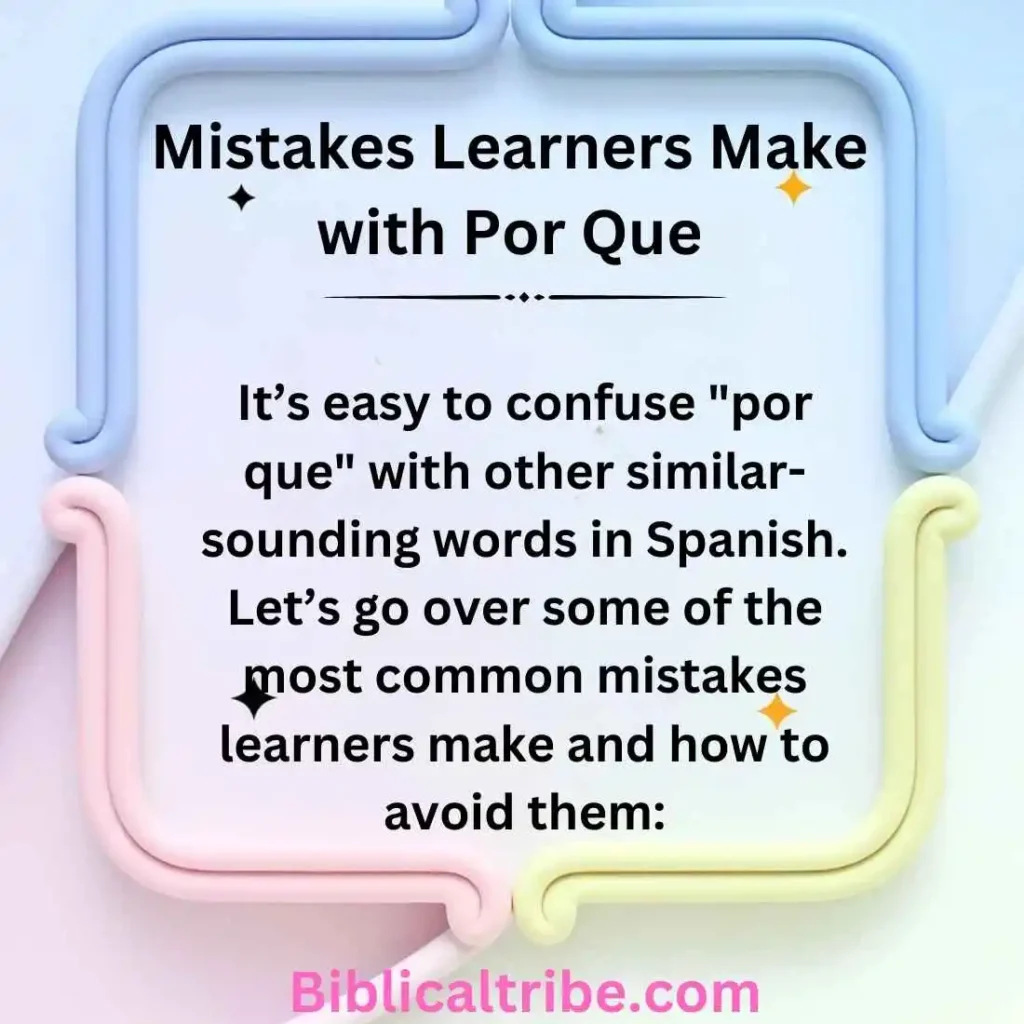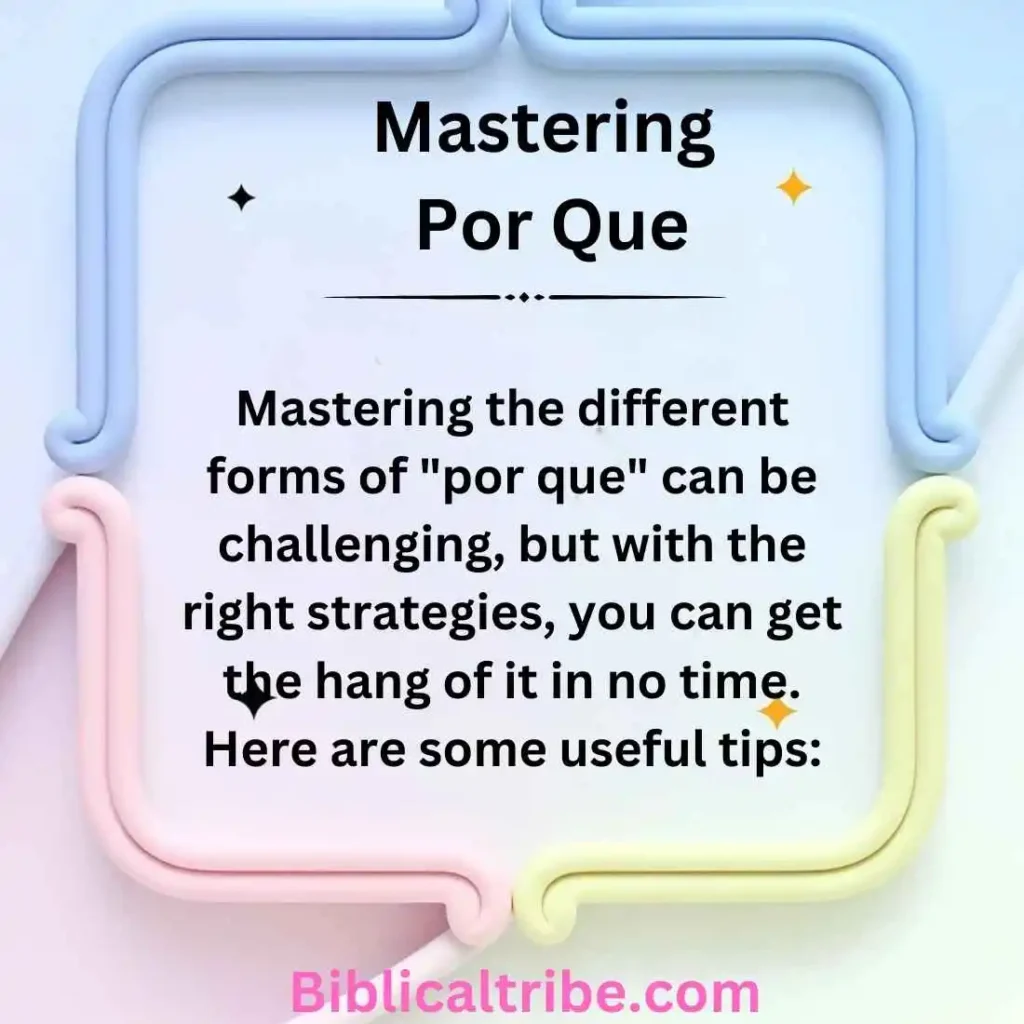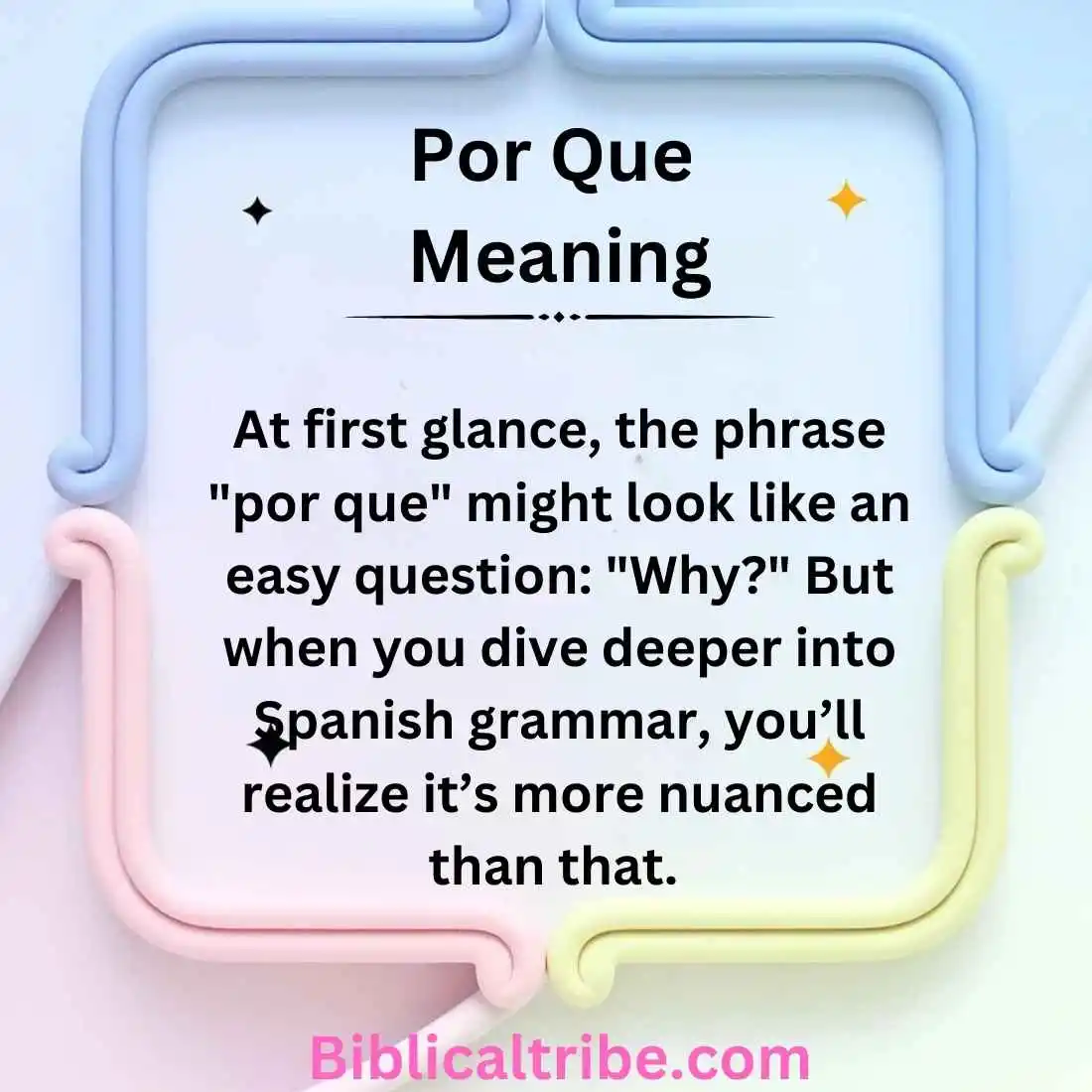Last Updated on February 5, 2025 by Ethan Richards
Are you curious about “por qué”, “porque”, “por que”, and “porqué”? If you’re learning Spanish, these four phrases might seem confusing at first—but don’t worry, you’re not alone!
Understanding the meaning and usage of “por qué” and its variations is essential for mastering the language and avoiding common mistakes.
In this simple guide for 2025, we’ll break down each term with clear explanations, real-life examples, and practical tips to help you use them with confidence.
Whether you’re a Spanish student, a traveler, or just passionate about languages, this guide will make learning easier.
Keep reading to unlock the secrets behind these tricky Spanish phrases and improve your skills today! 🚀
What Does “Por Que” Mean?
At first glance, the phrase “por que” might look like an easy question: “Why?” But when you dive deeper into Spanish grammar, you’ll realize it’s more nuanced than that.
In fact, “por que” is not a single phrase—it’s actually the combination of two separate words: “por” (for) and “que” (that). Together, they often appear in more complex grammatical constructions.
Common Uses of “Por Que”
- “Por que” appears when you’re using the subjunctive mood, or in certain formal contexts.
- It is used in indirect questions or to introduce a clause where the reason is explained or emphasized.
In short, “por que” is often part of a more intricate sentence structure rather than a standalone expression. Let’s now dive into how to use “por que” and its variations.
The Different Forms of “Por Que”
Spanish is a language full of nuance, and “por que” is no exception. While “por que” may seem straightforward, there are actually four main forms that change based on accent marks, sentence structure, and usage. Here’s a breakdown of each:
“Por Que” (Two Separate Words)
This is the most common form you’ll encounter, and it’s important to understand when and how to use it.
“Por que” appears in indirect questions and when the reason is not directly asked but implied.
- Example sentence: No entiendo por que lo hiciste.
Here, “por que” introduces the reason for the action but is used in a non-direct question format. This structure might be more common in formal or written Spanish.
When to Use It
- Use it when you’re introducing a subordinate clause explaining the reason for something, without directly asking a question.
- It often appears with formal phrases like “no sé por que” (I don’t know why).
“Por Qué” (With an Accent on “Qué”)
“Por qué” is used when asking direct or indirect questions. The accent on “qué” indicates that this is an inquiry, a request for a reason, and it typically follows a question mark in writing.
- Example sentence: ¿Por qué no viniste ayer?
The accent on “qué” is crucial here—without it, the meaning changes entirely.
When to Use It
- “Por qué” is used only when asking a question, either directly or indirectly.
- It’s part of many common Spanish question words like “cómo” (how), “dónde” (where), and “cuándo” (when).
“Porque” (No Accent)
“Porque” is used to mean “because”—this is the most straightforward form of the word. It’s a conjunction that connects a cause with its effect, providing the reason for an action.
- Example sentence: No fui al cine porque estaba cansado.
(I didn’t go to the movies because I was tired.)
When to Use It
- Use “porque” to provide an explanation or cause.
- It’s common in both spoken and written Spanish to give answers to questions.
“Porqué” (One Word, With an Accent)
This form is less common but still important. “Porqué” is a noun that means “the reason”. It is often used with an article, such as “el” (the), and refers specifically to the reason behind something.
- Example sentence: El porqué de su decisión no es claro.
(The reason for his decision is not clear.)
When to Use It
- “Porqué” is used when referring to the reason as a noun.
- It is commonly preceded by the article “el” or “un” to indicate a specific reason.
Common Mistakes Learners Make with “Por Que”

It’s easy to confuse “por que” with other similar-sounding words in Spanish. Let’s go over some of the most common mistakes learners make and how to avoid them:
- Mistake #1: Using “porque” when you should use “por qué”.
Correct usage: Always remember that “por qué” is used for questions, while “porque” is used to give explanations. - Mistake #2: Confusing “por que” and “porque” in indirect questions.
Correct usage: Use “por que” for non-direct questions and “porque” when explaining a cause or reason. - Mistake #3: Forgetting the accent on “por qué” in direct questions.
Correct usage: Always include the accent on “qué” when asking a question, or the meaning will change entirely.
When and How to Use “Por Que” in Everyday Conversations
Understanding the grammar behind “por que” is essential, but it’s just as important to know how to use it in practical conversations. Below are some real-life scenarios in which you’ll encounter “por que” and its variations.
Asking Questions
One of the most common uses of “por qué” is in asking questions. This is the basic form you’ll use when inquiring about the reason for something.
- Example question: ¿Por qué no me llamaste?
(Why didn’t you call me?)
In everyday conversations, “por qué” helps you find out the reason behind an action or event. Whether you’re asking a friend, family member, or colleague, this phrase is invaluable.
Expressing Doubts or Uncertainty
“Por que” can also be used in formal language or when expressing doubts about something. This is more common in professional or academic settings.
- Example sentence: No entiendo por que no se ha resuelto el problema.
(I don’t understand why the problem hasn’t been solved.)
This form allows you to express confusion or uncertainty without directly asking a question.
Differences Between “Por Que” and Other Related Spanish Phrases
Spanish has many phrases that are similar to “por que”, and knowing the differences can help you refine your Spanish skills. Let’s take a look at some of the most common ones:
“Para Qué” vs. “Por Qué”
- “Para qué” means “for what purpose” and is used when asking about the goal or intention behind an action.
Example: ¿Para qué quieres estudiar español?
(What’s the purpose of studying Spanish?) - “Por qué” refers to the reason something happens or is done.
Example: ¿Por qué estás aprendiendo español?
(Why are you learning Spanish?)
“Por Qué” vs. “Por Qué Razón”
While “por qué” is used in everyday questions, “por qué razón” is more formal and refers to the specific reason behind something.
- Example: ¿Por qué razón llegaste tarde?
(For what reason did you arrive late?)
This form is less common in casual speech but might be encountered in more formal writing or conversations.
Key Tips to Mastering “Por Que” and Avoiding Confusion

Mastering the different forms of “por que” can be challenging, but with the right strategies, you can get the hang of it in no time. Here are some useful tips:
- Use mnemonics: Create memory aids to help remember which form to use. For example, “Por qué” asks “Why”—think of the question mark as a visual reminder.
- Practice with native speakers: One of the best ways to learn the nuances of “por que” is by practicing with native Spanish speakers.
- Read in Spanish: Reading books, articles, or watching shows in Spanish can help you see how “por que” is used in context.
- Be patient: It takes time to internalize the different uses of “por que”. Don’t be discouraged by mistakes—keep practicing!
Frequently Asked Questions
- Can “Por Que” Be Used Interchangeably with “Porque”?
No, “por que” is used in formal contexts and indirect questions, while “porque” means “because” and explains reasons. - Why Is “Por Qué” Always Used with a Question Mark?
The accent on “qué” signals that it’s a question, so it needs to be enclosed in question marks in both written and spoken forms. - What’s the Best Way to Practice These Distinctions?
The best way is through regular practice, exposure to native Spanish, and reviewing examples from real-life conversations and media.
Conclusion
Mastering the correct use of “por que“ in Spanish is essential for clear communication.
Whether you’re asking questions, explaining reasons, or diving into more complex sentence structures, knowing the different forms of “por que” will help you avoid confusion and sound more like a native speaker.
Practice these tips, and soon you’ll be using “por que” effortlessly in your Spanish conversations.

Ethan Richards is an accomplished author and dream interpreter known for his insightful and thought-provoking analyses. With a keen eye for detail and a passion for biblical studies, Ethan helps readers unlock the secrets of their dreams, offering clarity and spiritual enlightenment.








